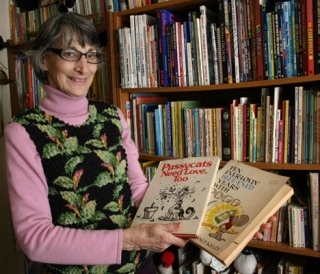Maria Kelly of Freeland collects books; lots of books.
But her favorites among them, she said, are her collection of cartoon and comic strip books, both vintage and contemporary.
Everything from The New Yorker cartoons, Garfield, Calvin and Hobbes, Dilbert, Doonesbury, and Berkeley Breathed to the vintage classics such as Krazy Kat, Li’l Abner, Pogo and the exquisite drawings of Searle’s Cats can be found on her shelf. Collections as unusual and disparate as the political Thomas Nast and the macabre Edward Gory can also be found in Kelly’s larder of laughs.
With her penchant for cartoons, Kelly has crowded her bookshelf with about 250 cartoon and comic-strip books that she’s been gathering for the past six years.
You may have seen part of her collection on display recently at the Freeland Library.
“I’ve always read the funnies in the paper from the time I was a kid,” Kelly said.
Born in Kansas, Kelly said a very dry sense of humor is typical of her Midwest family.
“My mother would read Pogo to us as bedtime stories, and she could do the dialects really well. In our family, we laugh at just about everything, but we don’t do it in an obvious way,” she said.
What started out as a family pastime became an influential part of Kelly’s life.
“Cartoons were my entertainment in grade school, but I could also see how they applied to what was going on in the world around me; that satire reflects society,” she said.
Seeing a child stretched out on the living room floor reading the “funnies” was a typical American sight in the years since the dawn of the newspaper comic strip.
Developed in the United States toward the end of the 19th century, comic strips were a marketing ploy originally created to draw Sunday edition customers.
But it would be Rudolph Dirk’s Katzenjammer Kids, which appeared on Dec. 12, 1897 in the Journal American, that would introduce the world to the first cartoon panels with dialogue.
Up until that time, no strip had ever been drawn as more than the one-panel format that was typical of the editorial or political cartoons of the day.
Dirk’s strip combined both the aspect of internal dialogue and panelized continuity, and in the process solidified the form of the modern visual narrative strip that endures today.
The idea that cartoons mirror the society of an era is intriguing to Kelly. But, she said, the things that make us laugh don’t change very much.
As a child, if Kelly was reading the most popular strips of the 20th century, she may have come across strips such as Gasoline Alley, Blondie, Nancy, Alley Oop, Gordo, Tarzan, Brenda Starr, Flash Gordon, Dick Tracy, Joe Palooka, Beetle Bailey and, of course, the most famous comic strip of all time, Peanuts.
But, as Kelly knew even as an astute child, comic strips provided something more than entertainment to sell newspapers.
Satire has always been the province of cartoonists who induce people to laugh at themselves, rather than to mock the government as political satirists were meant to do.
Nast, one of the most famous political satirists of the 19th century, could drive a politician out of office with his wit. He managed to successfully oust a corrupt New York City administration — the Tammany Hall Democrats led by William Magear “Boss” Tweed — with a series of cartoons in Harper’s Weekly and The New York Times between 1868 and 1871.
But cartoonists throughout the decades usually stuck to social satire, though they did manage to work in some political commentary from time to time, much as the staunch conservative Harold Gray did in his Little Orphan Annie strip when “Daddy Warbucks” famously confronted President Roosevelt and his New Deal.
Walt Kelly’s Pogo was banished to the editorial page for his take on Sen. Joseph McCarthy and his anti-communist witch hunt of the 1950s.
Even Bill Watterson managed to air his political views through a 6-year-old precocious child in Calvin and Hobbes from time to time, and everybody who read Doonesbury knew with certainty where Gary Trudeau stood on certain political issues; decidedly left of center.
But, Kelly said, there have been some big changes that she’s noticed over the years in the cartoon world, particularly the quality of the drawing.
She’s right.
During World War II, newsprint shortages became an inconvenient reality for publishers. Newspapers were forced to reduce in size and subsequently, less width in an edition meant less width for comic strips.
The luxury of telling a story with five-column wide panels was lost and without the space to illustrate, the visual rhetoric of the medium was seriously impaired.
The adventure strip disappeared by the 1980s and most of the space in every panel of every strip was devoted to rendering faces and filling speech balloons.
However, although they were forced to draw more simply in a smaller dimension and to let go of the adventure strip and the soap opera strip, the comic strip medium managed to produce new and imaginative family strips, kid strips and animal strips that remained full of vitality and pertinent to society.
Kelly finds the realm of cartoons an indispensable part of her life.
Books, she said, are the one thing she can talk about forever and her goal is to share them with the world, hoping to spread her love of them to her grandchildren and great-grandchildren.
“I never get tired of being around books. I can just pick one up and amuse myself all over again,” Kelly said.
“I love that.”


